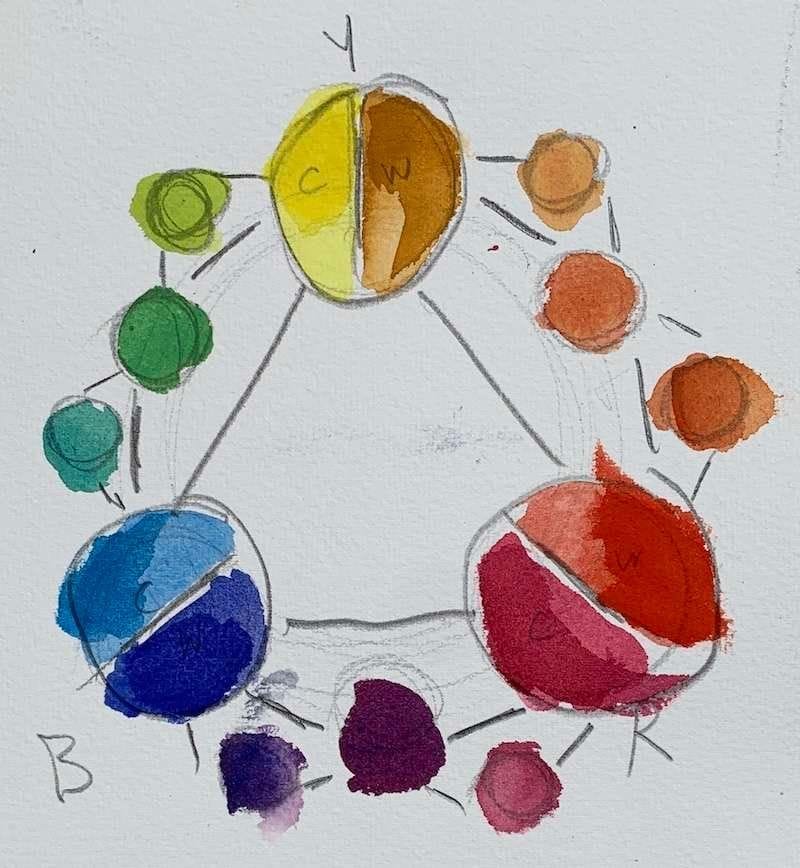How to Mix Watercolor the Right Way
Before you can throw caution to the wind with loose watercolor, you’ve got to nerd out on the basics. This 6-color split primary palette guide shows how solid fundamentals unlock expressive freedom.

Hey, before we dive into mixing watercolor and exploring the Six Primary Palette, let me say this: if you’ve been around this site for a while, you know it’s all about painting loose and expressive, throwing caution to the wind, and finding freedom in your art.
But here’s the truth — none of that happens without some fundamentals. Early in my journey, I realized my paintings were falling apart because I was ignoring the basics. At some point, I had to knuckle down and learn the “nerdy stuff”: color mixing, values, composition, and all the technical skills that give you control.
It wasn’t glamorous, but it changed everything. Once I had those essentials in place, I finally had the confidence and permission to paint the way I wanted — loose, raw, and expressive.
So, today we’re going to nerd out a bit on color mixing. Throughout this site you’ll find plenty of skill-building tutorials like this one, because I believe strong fundamentals don’t limit you — they unlock your freedom.
Mixing watercolor can feel tricky at first, but with the right palette and a little practice you’ll get clean, vibrant colors instead of mud. One of the best ways to start is with a split primary palette — six colors that cover warm and cool versions of each primary. From there, you can mix almost anything you need.
The 6 Primary Colors
Here’s a simple, reliable set:
- Warm Yellow: Yellow Ochre
- Cool Yellow: Cadmium Yellow Lemon
- Warm Blue: Ultramarine Blue
- Cool Blue: Cerulean Blue
- Warm Red: Cadmium Red Light
- Cool Red: Alizarin Crimson
Optional but helpful additions: Burnt Sienna, Raw Umber, and Neutral Tint.

Why the Split Primary Works
- Flexibility – You can mix both vibrant secondaries and more subtle neutrals.
- Control – Warm + cool choices let you push a mix brighter or duller.
- Consistency – Fewer paints = more predictable results.
Water and Pigment
Think of water as your “white paint.” Adding more water lightens a color’s value without dulling it.
- For light tints, start with the lighter pigment (ex: pink instead of straight red).
- Adjust your water ratio gradually until you get the transparency you want.
Mixing Secondary Colors
- Green: Cerulean Blue + Cadmium Yellow Lemon
- Violet: Ultramarine Blue + Alizarin Crimson
- Orange: Cadmium Red Light + Yellow Ochre
Complementary pairs (like red + green, or yellow + purple) also create muted tones and grays.

Grays and Browns
- Gray: Mix all three primaries (red, blue, yellow) in small amounts and adjust bias as needed.
- Brown: Mix red + green in different ratios for warmer or cooler variations.
Tubes vs. Pans
- Pans: Activate with water, build up slowly.
- Tubes: Easier to grab strong color quickly but may need rewetting if dried.
In Conclusion
With just six well-chosen primaries, you can unlock a full world of color. Create a simple color chart as you practice, and you’ll see how endless the possibilities are.
Continue Learning
👉 Next stop: the Watercolor Tutorials Hub to keep building your skills.
If you enjoy these kinds of raw insights and loose watercolor demos, you’ll feel right at home here. Subscribe to Crafted by Robert and follow along as I share painting inspiration, tips, and behind-the-scenes stories straight from my garage studio. 👉 Subscribe to Crafted by Robert




